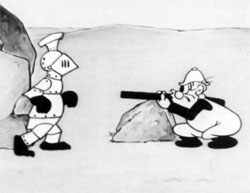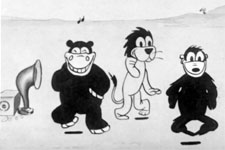
It’s a pretty short one today since it’s a time-crunch here to get something done in the next day or so! I’m really looking forward to having less things on the plate here; for some reason everything is sort of due at once. As I’m finishing the thing that’s due tomorrow, I took a break for a quick Thunderbean Thursday. I’ll have big news soon from Thunderbean – but we’ll get through the current things here first so I have something to share.
Today’s cartoon!
 To relax a little, I’ve been hunting through various cartoons that have used the music from the Rainbow Parades as stock music so we can have a ‘music only’ selection for a film or two on the ‘Rainbow Parades 2’ set. I came across this cartoon from the ‘Aesop’s Fables’ volume 1 Blu-ray, and thought it
To relax a little, I’ve been hunting through various cartoons that have used the music from the Rainbow Parades as stock music so we can have a ‘music only’ selection for a film or two on the ‘Rainbow Parades 2’ set. I came across this cartoon from the ‘Aesop’s Fables’ volume 1 Blu-ray, and thought it
Calling a cartoon Hunting in 1950 in 1926 seems like a great idea— and presents all kinds of possibilities.
Sadly, there isn’t *anything* in this particular film that would suggest that the film was set 24 years in the future. While it’s not clever in that way, there’s a lot of fun gags to make it at least an enjoyable but somewhat thin-plot-ed cartoon.
 The plot that is there consists of Al hunting. This includes chasing a bear with a rifle, then chasing a skating leopard (getting its spots knocked off at one point). There’s a few other little humorous moments including a knight’s armor gag, if that’s your thing. There’s also an enjoyable sequence featuring the various jungle animals dancing to piano music that has pretty happy animation. My favorite gag has Farmer Al waiting for a Lion to get his nails trimmed and sanded before Al’s allowed to shoot him- leaving him waiting on a rock and having a fantasy in a thought bubble of the dead lion. Somehow the dead lion’s body makes him giggle. Despite being around animals in nearly every film, he has a terrible animal rights record!
The plot that is there consists of Al hunting. This includes chasing a bear with a rifle, then chasing a skating leopard (getting its spots knocked off at one point). There’s a few other little humorous moments including a knight’s armor gag, if that’s your thing. There’s also an enjoyable sequence featuring the various jungle animals dancing to piano music that has pretty happy animation. My favorite gag has Farmer Al waiting for a Lion to get his nails trimmed and sanded before Al’s allowed to shoot him- leaving him waiting on a rock and having a fantasy in a thought bubble of the dead lion. Somehow the dead lion’s body makes him giggle. Despite being around animals in nearly every film, he has a terrible animal rights record!
As I’m trying to find whatever music pieces I can for the Rainbow set, I was especially happy to hear the track on this one since it features a pretty nice piece of music from the end of Bold King Cole. What else can you identify?
Have a good week all, and stay away from stampedes!


 Steve Stanchfield is an animator, educator and film archivist. He runs Thunderbean Animation, an animation studio in Ann Arbor, Michigan and has compiled over a dozen archival animation DVD collections devoted to such subjects at Private Snafu, The Little King and the infamous Cubby Bear. Steve is also a professor at the College for Creative Studies in Detroit.
Steve Stanchfield is an animator, educator and film archivist. He runs Thunderbean Animation, an animation studio in Ann Arbor, Michigan and has compiled over a dozen archival animation DVD collections devoted to such subjects at Private Snafu, The Little King and the infamous Cubby Bear. Steve is also a professor at the College for Creative Studies in Detroit.






















A cute cartoon, with a surprisingly well-synchronised soundtrack. The music we hear while Farmer Al Falfa is hunting the rabbits comes from the live-action intro to Van Beuren’s “Spinning Mice”. I can’t identify any other cues offhand, but if I have a few minutes later on I’ll cross-reference them against the Rainbow Parades and see if I find any matches.
I was very entertained by the manicure scene. According to what I remember of the novels of Sinclair Lewis, a manicure was a sign of social status in the 1920s. Male characters with manicured nails — and there are a lot of them in these novels — tend to be vain, smug, pompous, and self assured. On the other hand (I didn’t intend a pun here, but I’ll let it stand), in Lewis’s MAIN STREET, Mrs. Kennicott is distressed to learn that her new husband, though a prosperous doctor and community leader, still trims his fingernails with a penknife. The manicurists themselves were presented as pretty girls and very flirtatious, dependent as they were upon earning tips.
So in this 1926 cartoon, it makes sense that the lion, as king of beasts, would have his claws professionally manicured. Farmer Al would definitely be one of the penknife-wielding hoi polloi.
There is no doubt in my mind that Paul Terry had a manicure every week — and that he was a lousy tipper.
There’s a lot to enjoy about this short, in spite of it being a pre-sound Paul Terry cartoon – the gags have a snap to them, the inkblot animation moves at a brisk pace, and the music fits in well despite having been composed and arranged years after this short’s release. There’s also a bit of blood at the 2:55 mark, during the hunter’s fantasy of a dead lion, which might be the earliest use of sanguine humor in animation!
I can see this being one of the shorts Harman, Ising, and others were watching in the studio’s privacy from copied film prints, taking notes of what works and what didn’t, before implementing them into an Oswald short.
One of the very early ones to feature a ‘director’ system where there was one lead animator– the director himself– with other animators working as either assistants or in their own scenes. I think Jerry Shields was the director here. This was around the time Bill Tytla was promoted? to full time animation work on these Fables.
You can see a great example of early Tytla in THE WHITE ELEPHANT (1929). After the shutdown of Fables, he would return to Terry in early 1931 after his vacation in Europe. More of these silent Fables need to be uncovered and I’m glad there are efforts of some caliber to recover them all.
In fact, the John Foster, Harry Bailey and Frank Moser animations can also be glimpsed, and given that all three were promoted to director of their cartoons, this calls into question your theory that Jerry Shield was the director of this cartoon.
Check out those Alice-esque animals!
It’s funny how Walt went from copying every studio to every studio copying him.
“What else can you identify?”
Glad you brought this up, I’ve been tracking down re-issues of silent cartoons to newsreels to find all available Sharples’ music from Van Beuren. The only cartoons from the 2nd half of Rainbow Parades I haven’t been able to find any music clips for are “Neptune Nonsense”, “A Waif’s Welcome”, and “It’s a Greek Life”. (I’ll e-mail them to you when I’m done)
Here’s what I was able to identifiy based on this cartoon alone:
0:00 – opening to “Toonerville Trolley”
0:13 – 1st few scenes of “Spinning Mice”
1:04 – unknown (probably an unused Sharples cue)
1:24 – random scenes from “The Merry Kittens”
2:19 – thunderstorm from “Bold King Cole”
2:39 – trolley scene with Mr. Bang and The Skipper in “Toonerville Picnic”
3:31 – other thunderstorm scene from “Bold King Cole”
3:49 – kittens sprayed with water in “The Merry Kittens”
3:53 – yet another thunderstorm piece from “Bold King Cole”
3:57 – kittens jumping out of dog’s ball of yarn in “The Merry Kittens”
4:02 – unknown (probably a music track from a different library)
4:27 – kittens chasing wind-up mouse in “The Rag Dog”
5:12 – final scene in “Bold King Cole”
5:39 – unknown (probably an unused Sharples cue)
1:24 is actually from “Cupid Gets His Man”, when we first see the W.C. Fields caricature heckling his lady neighbor.
I was going to comment an update, 1:40 is where music clips from “Merry Kittens” begin to play.
The W.C. Fields and Edna May Oliver caricatures do have actual names (according to the model sheets, they are Mr. Patch and Miss Primm).
I can’t help but wonder if this was one of the first Stuart Aesop Fable’s compiled for the package, considering the placement of the Sharples’ cues are put into a bit more consideration and the moral is present here.
I’ve always theorized this was THE very first cartoon prepared for this package for the reason you stated before. “Lindy’s Cat” is another that I wouldn’t be surprised was one of the first handful as well, considering that has the moral intact as well and ends with the same ending fanfare as this. Oh, if only the production codes for these would surface, not unlike how some internal docs for the Bray TV package has.
Is that a small brontosaur at the end of the line streaming out of the hut (and in the middle of the line three times before)?
The title “Hunting in 1950” fascinates me. The most famous futurist, Buck Rogers, had yet to appear; in fact, Amazing Stories, the first magazine devoted to science fiction, was cover dated April 1926. “Metropolis” will come out in 1927. We just have to credit Farmer Al Falfa with feeling or anticipating the tenor of his times.
Well, either a small Brontosaurus or some other variety of sauropod. They appear in many Aesop’s Fables cartoons, and not only those with a Stone Age setting. Sometimes they’re pictured with external ears. The Brontosaurus displayed at the American Museum of Natural History in New York was the first permanently mounted sauropod skeleton anywhere in the world and has long been one of the museum’s most popular exhibits. It inspired Winsor McCay’s Gertie and evidently made a strong impression on Paul Terry as well.